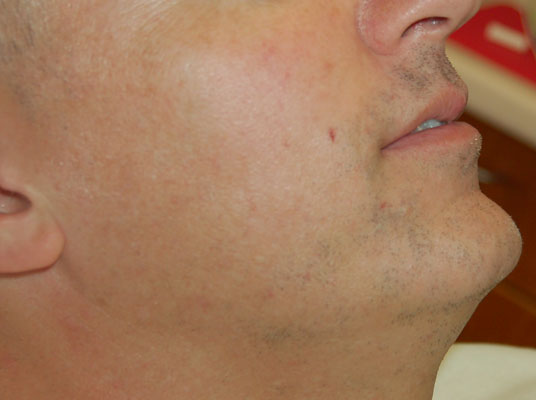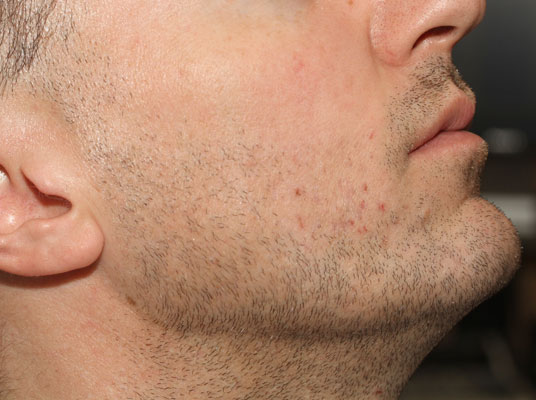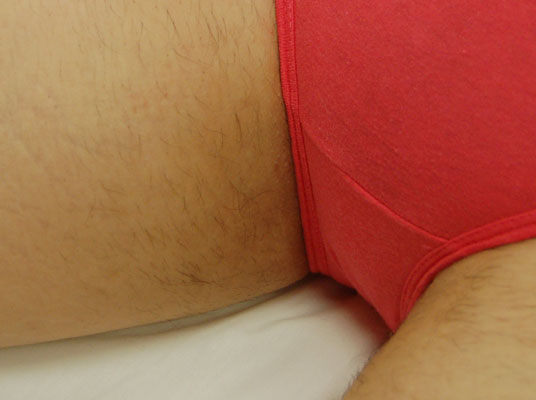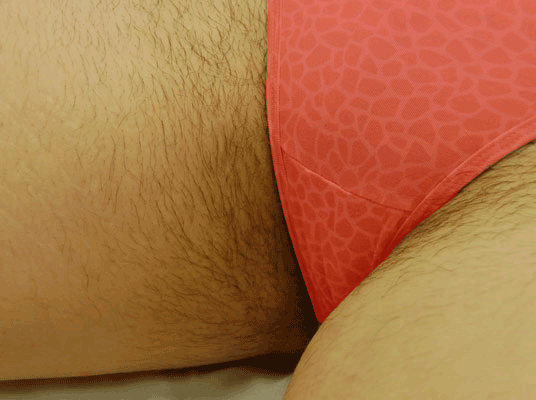Lasers are now the most effective way to treat most unwanted hair. Our Lumenis LightSheer Desire Laser uses state-of-the-art technology to reduce hair growth permanently and painlessly. There is no need for numbing creams with the proprietary ChillTip technology. The unique high-speed hand piece, used for larger areas, cuts treatment time dramatically. There is no more effective instrument for permanent hair reduction on the market today.
Results gallery






FAQ
The LightSheer laser emits an intense light that is very well absorbed by melanin, the main source of pigment in the skin, so anything with melanin in it is heated up by the light. A hair has more of this pigment in a larger volume than any other part of normal skin. Therefore hairs are heated more than the rest of the skin, and it is possible to destroy the hair without damage to the skin.
The short answer: it is very effective as long as the hair is not blond, red, or white.
The long answer: Skin color and hair color make a difference in how well it works, and in what settings are needed. The easiest person to treat is a dark-haired, pale-skinned person. If your hair is white or blonde, the current lasers on the market will not work well for permanent reduction.
The darker your skin, the more care must be taken to avoid damaging the normal pigment cells. For this reason, lower power is needed, and/or longer pulse widths. Because of these requirements, more treatments are needed for good results in darker-skinned people and the results are less reliable.
Each treatment reduces the number of hairs; on average it takes 4–6 treatments to satisfy most people. Treatments are usually scheduled 1–3 months apart.
Remember that you must be very sure that you will not ever want hair in the area treated. Even after a single treatment the density of the hair will be permanently affected.
Each laser pulse causes a stinging sensation. While older models of laser can be quite painful, sometimes requiring anesthetic, the new LightSheer Desire is MUCH gentler. Most patients describe a mild stinging sensation. No anesthetic is ever needed.
The larger headpiece that is used with this laser also has a vacuum attachment that produces a sucking sensation—peculiar, but not painful. This vacuum improves contact with the laser at the proper distance, which reduces the amount of blood in the skin being treated, thus causing less discomfort. More effect on the target (the hair) and less on the surrounding tissue—thus less discomfort and less chance of side effects.
Redness in the area treated can happen, but it usually resolves by the next day. With the LightSheer Desire, post-treatment redness is actually uncommon. There is generally no interference with any activity desired, although because of possible redness I recommend not scheduling treatment of any visible areas within 2 or 3 days of an important public or social appearance, just in case!
The area to be treated is shaved before treatment. After treatment, dead hairs are often slowly extruded over the following two weeks, and improvement is noted after that, even with only one treatment.
If you have very dark skin, special care must be taken to avoid damaging the pigment cells in the skin. Recent advances in lasers permit safe hair removal even in dark-skinned people. The LightSheer is one of the best at this.
The settings that are adjusted for different skin types are:
- the total amount of energy delivered (fluence)
- the length of time over which that energy is delivered (pulse width)
- size of the laser spot
Possibly.
- Tanned skin is harder to treat than non-tanned skin. If you have a suntan, your skin is more easily damaged by the laser, so you are more likely to have some post-treatment discoloration. With the LightSheer we can adjust the parameters to reduce this possibility, but it is still better if you are not tan. We recommend at least a month of sun protection before having laser treatments.
- If you have a history of herpes simplex in the area treated, the irritation of the laser can activate the infection. Let us know if you have such a history; it is easy to prescribe an antiviral to take before the treatment to reduce such a possibility.
- Many medications, including some herbal remedies (e.g., St. John’s Wort), can theoretically increase photosensitivity. These are very rarely (if ever!) any problem at all, but it is also usually easy to stop the medicine for a few days before the laser treatment. This problem has never occurred with any of our patients to date.
- Do not wax before the treatment; this completely undermines the treatment. If there is no hair there, the laser won’t treat it. Please don’t wax for a couple of months before treatment.
- Don’t wear makeup or sunscreen when you come in. We will wash it off, anyway, but it’s just as well not to have it on. You will need to wear sunscreen after the treatment, if the area treated is in a sun-exposed place: this will reduce the chance of inducing transient skin discoloration.
- Do you have any tattoos in the area to be treated? We won’t be able to treat directly over a tattoo. This is also true of skin-colored cosmetic tattoos.
Not necessarily.
The great majority of the hairs that have been removed will never grow back. But as the years go by, hair follicles that were previously dormant may be recruited, and some hair regrowth will occur. The number of hairs will be dramatically reduced, and the hairs that do regrow will almost always be thinner, paler, and harder to see.
- Mild discomfort/stinging at the area of treatment during and after treatment. Most people find this very tolerable. The area treated may rarely feel like it has had a mild sunburn for a day or two.
- Redness and swelling of the area treated. This is actually uncommon with the LightSheer Desire. If it occurs, the redness can easily be covered with makeup if desired. It may last as long as a few days, but that is very unusual.
- Folliculitis (inflammation or infection of the hair follicle). Inflammation around and in the hair follicles is not common with the LightSheer Desire (a major difference from the older lasers) but it can happen. Even when it happens it is usually asymptomatic, but it can itch if you are sensitive to itching.
The following are very rare occurrences with the LightSheer Desire (most of these we have NEVER seen):
- Bruising of the area. Would resolve in days.
- Crusting or scab formation. Tiny scabs can form over the follicles; these resolve in days.
- Change in skin color of the treated area. Hair removal laser treatments can cause decreased or increased pigment in skin in the areas treated; this is more common in darker skin. This is almost always transient (lasting for several weeks), rarely can last months, very rarely it could be permanent. For this reason in very dark-skinned patients we will sometimes recommend a “test spot” be done, in an inconspicuous place. Also, we always start with relatively low settings on the laser to see how the skin responds before moving to higher settings.
- Blistering of the treated area. This would be more likely in dark-skinned patients or people who are suntanned.
- Lack of response. Occasionally the laser treatment will fail to reduce the number of hair follicles or diameter of the hair shafts. A small minority of people have hair that does not seem to respond to laser treatments.
- Scarring. This is, so far, only a theoretical concern with respect to diode lasers like the LightSheer—an advantage of the modern hair removal lasers. So far there have not been any case reports of scarring from these lasers. However, it is believed that the potential for scarring exists. For this reason, we ask if you have had any history of abnormal scarring—especially keloids. Special caution would be indicated in a person with a history of keloids, particularly if the person has thick, coarse hair.
